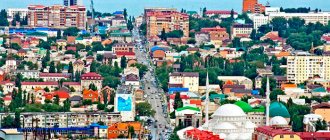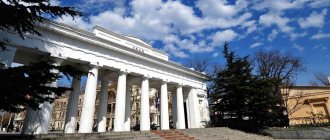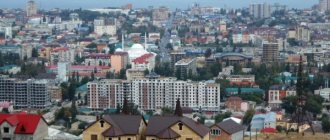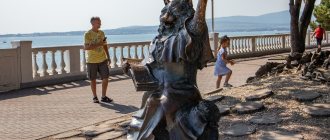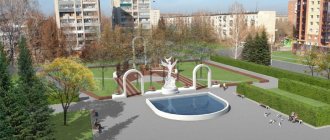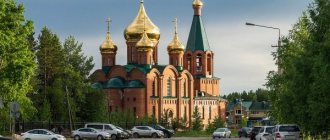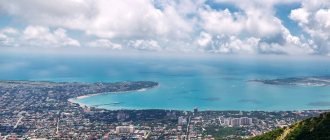The city of Blagoveshchensk is included in the list of the oldest cities in the Russian Far East. The first settlement formed on the site of the modern city was the Ust-Zeysky post, which was founded in 1858. A little later, after the construction of the Church of the Annunciation, the village was renamed Blagoveshchensk.
During your stay in the city, you have the opportunity to see ancient religious landmarks that were built during the existence of the settlement in this place.
Amur embankment
The most popular place among citizens and guests of Blagoveshchensk is the embankment, which stretches along the Amur River for several kilometers. It offers magnificent views of the river and the Chinese city of Heihe. In the center of the embankment stands a three-meter high monument to the founder of the city, Count Nikolai Muravyov-Amursky. The favorite place of the townspeople is the rotunda - a gazebo on the banks of the Amur with a transparent dome and marble columns.
Along the embankment there are numerous architectural and sculptural monuments, as well as parks, cinemas, shopping and entertainment complexes. In the evenings, musicians gather here, sometimes an orchestra plays, and the townspeople dance.
Natural attractions
The Amur region has very beautiful nature; you can enjoy the clean air and plants characteristic of the region by taking a ride around the outskirts of the city of Blagoveshchensk.
Embankment of the Amur River
Blagoveshchensk has one of the most beautiful embankments in the region. Walking along it you can look at China, located on the opposite bank across the river.
The city embankment is located on the street. Krasnoflotskaya, its length is about 8 km. Due to the border status, observation posts have been installed in some places of the walking area.
The city embankment is decorated with monuments installed on it:
- A dog named Druzhok, who, despite the severe flood in 2013, did not abandon his home and continued to guard it.
- Russian statesman Nikolai Muravyov-Amursky, who served as governor-general of Eastern Siberia in the mid-19th century.
- An armored boat that served during the events of the Great Patriotic War.
At the very beginning of the Embankment there is a memorial stone with a tablet listing the names of all the pioneers of the region.
While walking along the Embankment, you can take a ride on a pleasure boat or use the services of a sports equipment rental service. Here you can ride a bicycle, scooter, roller skate or hoverboard.
For young children, there are trampolines and swings on the Embankment.
Khingan Nature Reserve, Amur Region
Near Blagoveshchensk there is the Khingan Nature Reserve. It occupies a large territory of the Amur Plain, 1/3 of which is occupied by low hills, which are spurs of the Lesser Khingan. Mostly deciduous trees grow here, with a small sprinkling of conifers. The most common trees are oak, aspen and birch.
It’s interesting to see the unique Khingan Nature Reserve in Blagoveshchensk
Also, in the pristine virgin forests of the Amur region, unique rare trees can be found:
- yellow birch trees;
- Amur lindens;
- Japanese elms;
- Manchurian ash trees;
- Korean cedars;
- Siberian spruce;
- whitebark firs.
On the flat territory of the protected area there are sedge-reed bogs, mixed-grass meadows and birch groves.
The main attraction of the protected area is the Red Book birds nesting here:
- Japanese cranes;
- Far Eastern storks;
- white-naped cranes.
Triumphal Arch
One of the main attractions of the city of Blagoveshchensk is the Arc de Triomphe. Installed on the embankment, this is a copy of the royal gate. It was built on the banks of the Amur River to welcome the future Emperor Nicholas II. He was then returning from his trip abroad (the Tsarevich visited several countries, including Egypt, India and Japan). In the late 1920s, the arch was damaged during a flood, and in the 1930s it was completely demolished. It was restored from surviving photographs only in 2005.
The arch is a gray structure with shades of pink, 24 m high. The main difference between the new arch and the previous one is the icon in the center. In the last century, Saint Nicholas the Wonderworker was depicted on it. Today the last Russian emperor, Nicholas II, looks at the Amur.
Amur Regional Drama Theater
Amur Regional Drama Theater
Blagoveshchensk
The first amateur performances were staged in Blagoveshchensk back in 1860. Dramatic performances were first staged in the city barracks: the lower ranks of the line battalion and artillery battery prepared plays of the classics. 20 years after another successful production, the Public Assembly decided to allocate a separate room for the artists. It was built in the city center in 1889.
There was no permanent troupe at that time, so itinerant actors, guest performers and entrepreneurs played in the theater. Only in 1912 the first group of full-time artists appeared, and already in the 1930s the theater became regional. On tour, the troupe of the Amur Drama Theater traveled almost the entire Soviet Union, visited the construction of the BAM, performed in Siberia and the Volga region, Central Asia and Yakutia, Ukraine and Sakhalin.
Today on the stage of the Amur Drama Theater you can see classical performances and modern productions: from “The Queen of Spades” by Alexander Pushkin and “Tartuffe” by Moliere to “The Ghoul Family” by Vasily Sigarev and “Selfie with Sclerosis” by Alexander Volodarsky.
Shopping arcade "Mauritania"
At the beginning of the 20th century, the Mauritania shopping arcades were built on the embankment. At that time they traded mainly in food products. In Soviet times, the premises served as a river station. Now it is occupied by the Institute of Geology and Environmental Management, Far Eastern Branch of the Russian Academy of Sciences.
Scientists are still wondering why the building was called “Mauritania”. According to one version, the reason is the unusual architecture with pseudo-Gothic elements - lancet windows and turrets on the roof. By the way, it was here that the writer Anton Chekhov visited in the 19th century.
Museum of Local Lore
The Amur Regional Museum of Local Lore named after Novikov-Daursky is located in one of the most beautiful buildings in the city. At the end of the 19th century, this building housed a branch of the trading company. Its founders, the Germans Gustav Albers and Gustav Kunst, traded in the Far East. Today the museum's collection includes over 160 thousand objects. Separately, we can highlight collections on archaeology, ethnography, and numismatics. Many items are unique: for example, here you can see the Ust-Nyukzhinsky meteorite and the costumes of Evenki shamans
Address: st. Lenina, 165
Phone: +7 (4162) 52-24-14
Opening hours: Tue–Sun 10:00–19:00, Mon – closed, last Friday of the month – sanitary day
Website: https://museumamur.org
Climatic conditions
Blagoveshchensk (people come from different parts of the country to see the picturesque nature of the region) is located in a zone of sharply continental climate, with severe frosty winters and humid hot summers. The average annual temperature in the warm season is on average +5°C, in the cold season -2°C.
Average temperatures by month:
| month | day °C | night °С | rating |
| January | -17,7 | -26,0 | 2,5 |
| February | -12,9 | -23,4 | 2,5 |
| March | -4,2 | -14,3 | 2,5 |
| April | +9,2 | -0,7 | 4,2 |
| May | +19,4 | +8,2 | 4,8 |
| June | +24,8 | +13,2 | 4,9 |
| July | +27,7 | +15,9 | 4,6 |
| August | +25,4 | +13,8 | 4,9 |
| September | +17,9 | +7,0 | 4,8 |
| October | +7,2 | -1,0 | 4,2 |
| november | -6,4 | -12,6 | 2,5 |
| December | -17,1 | -23,7 | 2,5 |
According to the comfort rating, June and August are considered the most favorable months for traveling to Blagoveshchensk.
Climatic conditions of Blagoveshchensk:
| month | sunny days | precipitation in mm | wind speed in m/s | rainy days |
| January | 5 | 3,59 | 2,4 | 1 |
| February | 2 | 6,30 | 2,4 | 1 |
| March | 7 | 9,33 | 2,9 | 4 |
| April | 15 | 10,63 | 3,3 | 7 |
| May | 19 | 28,79 | 3,1 | 12 |
| June | 19 | 48,72 | 2,4 | 14 |
| July | 23 | 48,23 | 2,4 | 15 |
| August | 20 | 39,77 | 2,4 | 15 |
| September | 20 | 30,10 | 2,8 | 11 |
| October | 18 | 23,34 | 3,0 | 6 |
| november | 12 | 6,81 | 2,6 | 1 |
| December | 6 | 6,96 | 2,5 | 1 |
Absolute minimum and maximum climatic indicators in Blagoveshchensk:
| month | average temperature | temperature minimum | temperature maximum | precipitation rate |
| January | -21,8 | -27,1 | -16,0 | 7 |
| February | -17,3 | -23,8 | -10,6 | 7 |
| March | -6,8 | -12,8 | -0,7 | 13 |
| April | +4,2 | -1,5 | +10,3 | 28 |
| May | +12,5 | +6,3 | +18,4 | 59 |
| June | +19,2 | +13,9 | +24,2 | 85 |
| July | +21,7 | +17,4 | +26,1 | 130 |
| August | +19,5 | +15,2 | +24,1 | 102 |
| September | +12,8 | +8,2 | +18,0 | 74 |
| October | +2,3 | -1,8 | +7,2 | 36 |
| november | -10,1 | -14,2 | -5,6 | 15 |
| December | -20,4 | -24,9 | -15,7 | 11 |
Cathedral of the Annunciation of the Blessed Virgin Mary
The Cathedral in honor of the Annunciation of the Blessed Virgin Mary was built in 2002. Previously, the oldest church in the city was located on this site. However, in the 1920s the temple burned down. Now the cathedral has 7 gilded domes. The bell tower, which is more than 32 meters high, is also topped with a dome. The main value is the Albazin Icon of the Mother of God, which is considered miraculous. According to legend, it appeared on the Amur in the middle of the 17th century.
Next to the temple there is a monument to Muravyov-Amursky and his associate Saint Innocent.
Address: per. Reelochny, 15
Phone: +7 (4162) 44-66-24
A little history
The appearance of Russians on the site of present-day Blagoveshchensk dates back to 1644, but not for long: 45 years later an international treaty was signed, according to which these territories ceded to China. It was only in 1856 that the city of Blagoveshchensk was officially founded, when it was necessary to secure the left bank of the Amur for the Russian Empire. For this purpose, Cossack families and detachments of soldiers were sent here. The city received its name from the Cathedral of the Annunciation of the Blessed Virgin Mary, founded in 1858.
In 1900, during the so-called Boxer Rebellion in China, Blagoveshchensk was bombed from the opposite bank of the Amur. In response, mass pogroms took place in the city, directed against its Chinese residents.
Dinosaur Graveyard
The dinosaur cemetery is a natural attraction of Blagoveshchensk. This is the only city in Russia with a dinosaur cemetery on its territory. At the same time, new remains of ancient animals are still being found there. The first unusual finds were discovered at the beginning of the 20th century. Giant reptiles lived in these places about 65 million years ago and were among the last dinosaurs on Earth.
A unique prehistoric herbivorous lizard discovered at the Annunciation Dinosaur Cemetery was named Amurosaurus.
The paleontological museum in Blagoveshchensk houses the country's largest collection of prehistoric dinosaurs. There you can see authentic bones of dinosaurs: Amurosaurus, Kerberosaurus, Olorotitan, Archaravia. All of them were found at different times in the Amur region.
Address: per. Relochny, 4.
Phone: +7 (4162) 52-34-54, +7 (4162) 33-27-10, +7 (4162) 54-42-76.
Opening hours: Mon-Fri 8:00–17:00, excursions are available only upon prior request
Website: https://pm.amurnc.ru/
Train Station
The station building was built in 1915. Work started in 1908, when the construction of the Amur Railway began. The railway itself was opened in 1913. The first train traveled along the Blagoveshchensk – St. Petersburg route. The station building was built in the old Russian style and is more reminiscent of a tower than an administrative building.
Address: st. Stationnaya, 70
Monument to Druzhka
Perhaps the most beloved monument by Amur residents. It is dedicated to a real dog, which became known after the great flood in 2013. The friend remained to guard his house in the village of Vladimirovka, Blagoveshchensk district. His owners evacuated, leaving the dog with neighbors who had not yet been flooded. But she ran back. A devoted friend was found on the threshold of a house: the brave dog stood up to his neck in water, but did not leave his post.
Now the 400-kilogram bronze dog rests its paws on the parapet of the embankment and peers into the Amur - guarding the border. Druzhka’s nose is polished to a shine: people believe that if you rub it and make a wish, it will definitely come true.
Friendship Park
Friendship Park appeared in Blagoveshchensk in the 1990s. It is intended to emphasize good neighborly relations with our eastern neighbor, China. Some decorative elements of the park are made in Chinese style. The park has recreation areas, attractions for children, and a floating fountain. At the end of the park at the intersection of Kalinin and Institutskaya streets there is the Church of St. Xenia of Petersburg.
Address: st. Kalinina, 134/1
Monument to the Holy Blessed Prince Peter and Princess Fevronia of Murom
Since 2008, July 8 has been celebrated as the Day of Family, Love and Fidelity. A year after the introduction of the holiday in Blagoveshchensk, the first stone was laid in the place where a monument to the saints, who are symbols of this day, was to be erected. And two years later, the figure of the eternally loving and faithful spouses was revealed to the eyes of the residents.
Location: St. Innocent Lane - 6.

